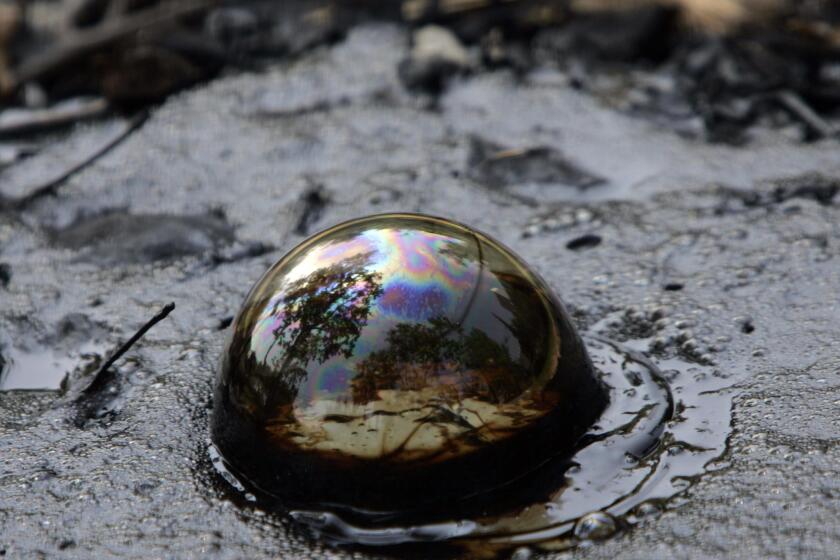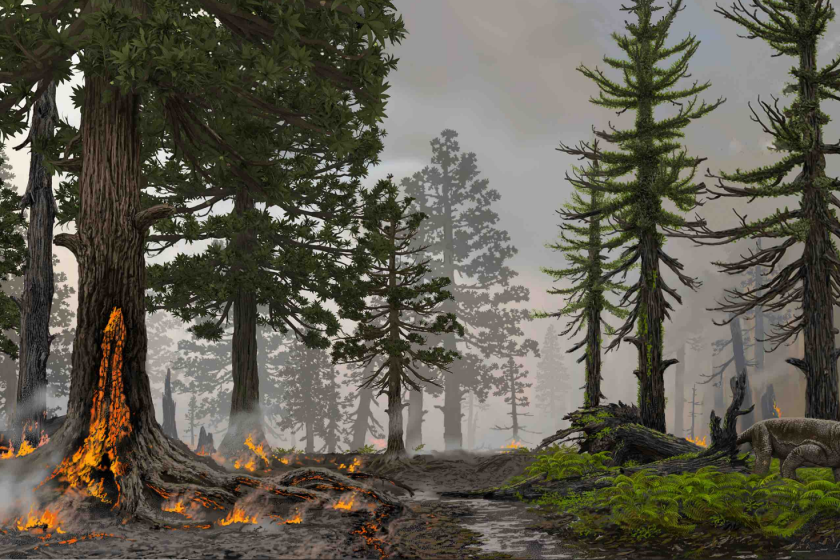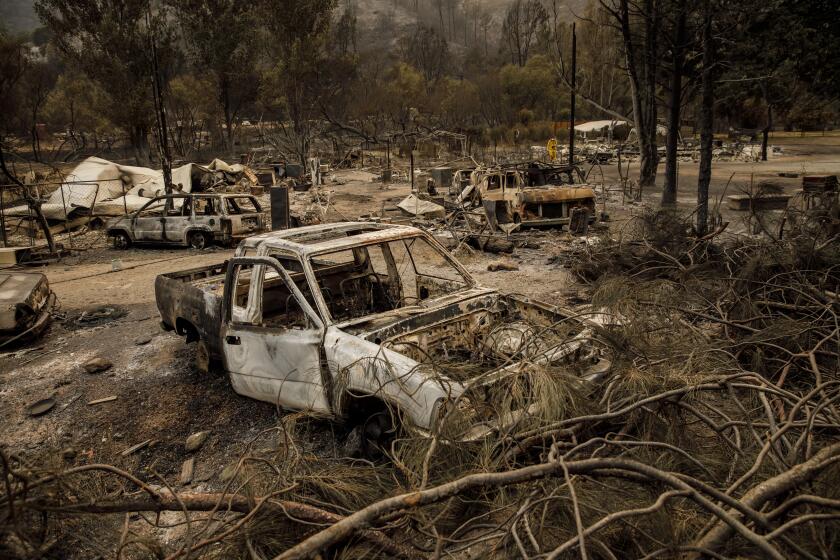Wildfires once fueled extinctions in Southern California. Will it happen again?

- Share via
Tens of thousands of years ago, before the last ice age ended, vast herds of saber-toothed cats, giant sloths, American camels and other fantastic beasts roamed Southern California.
Then they were gone. The culprit behind their disappearance has never been identified.
Scientists have floated theories over the decades — a dearth of prey for carnivores, overhunting by rapacious humans — yet none has fully explained why the ecosystem here changed so dramatically at the end of the Pleistocene epoch, some 13,000 years ago.
In a major new study, researchers used tangles of bones from the La Brea Tar Pits, ancient mud from the bottom of Lake Elsinore and an array of other evidence to piece together the region’s archaeological record. The results, published Thursday in the journal Science, paint an astonishingly detailed picture of the events that led to the animals’ disappearance.
The findings are startling, both for the clarity of the evidence and for their disturbing similarities to today’s ecological crisis.
The authors concluded that the magnificent mammals of the Ice Age vanished with shocking speed when a period of warm, dry climate conditions coincided with the arrival of humans and a tool they struggled to contain: fire.
The La Brea Tar Pits were recognized as one of the world’s First 100 IUGS Geological Heritage Sites for their stunning Ice Age fossil record.
Even with only a tiny fraction of today’s population and infinitely less powerful tools, it took the area’s earliest human inhabitants less than 200 years to utterly transform Southern California’s landscape. Fires they started but could not control led to the swift demise of species that had ruled the land for millennia and fundamentally reshaped the ecosystem from a prehistoric woodland to the chaparral we recognize today.
Emily Lindsey, a curator at the La Brea Tar Pits and the study’s senior author, said the take-home message is clear.
“Humans were responsible for these fires, and the fires coincide exactly with the complete disappearance of megafauna from the environment,” she said. “They go away and they never come back.”
Scientists who were not involved in the research said it offers the most complete picture yet of California’s first human-driven ecological catastrophe, and offers valuable insights into where our current one may be heading.
“This paper provides a picture of how climate change can completely transform ecosystems,” said Jarmila Pittermann, a plant physiologist at UC Santa Cruz who researches extinction. “It is super-convincing and a massive warning to all of us.”
Scientists are using a UC Santa Cruz greenhouse to re-create the mass extinction that wiped out the dinosaurs. They want to learn why some species survived.
The study began with an effort to use radiocarbon dating to determine the ages of a few hundred of the approximately 3.5 million bones unearthed over the years from the La Brea Tar Pits. Unlike other methods of fossilization in which organic matter is replaced over time by sediment, tar preserves a bone’s collagen, which is more conducive to getting a precise radiocarbon date.
The nature of the tar pits makes it easy to determine which animals died there, but harder to know when they died. Many pits were active over thousands of years, entrapping countless animals whose remains muddled together.
Each bone in the mid-Wilshire museum’s collection is tagged with the date and pit number where it was found. As the researchers started working through fossils extracted from Pit 61/67, they made a surprising discovery: The pit had been active during the years of the mass extinction.
Specimens older than 13,000 years came from a variety of animals once common in Southern California: saber-toothed cats, dire wolves, western horses, bison, coyotes.
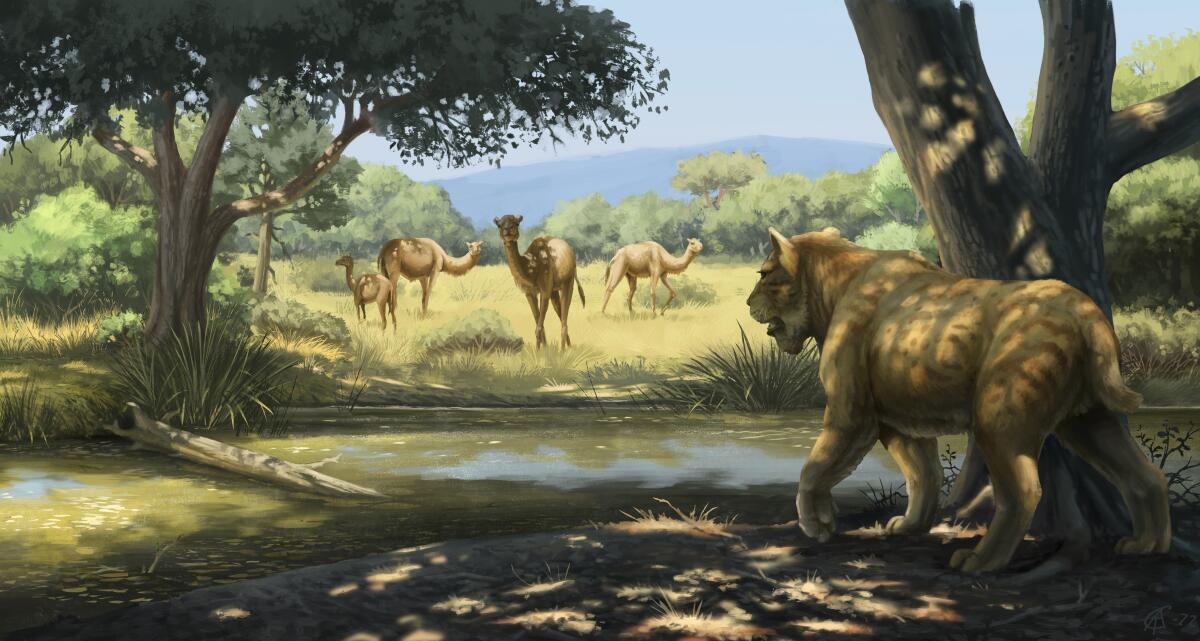
But after the 13,000-year mark, that diversity disappeared, said Regan Dunn, a curator at the tar pits and co-author on the study. The only big mammal bones found in the pit from that point on were from coyotes, ancestors of the wily canines still roaming the hills today. (“They’re survivors. They can adapt to different environments,” Dunn explained.)
The tar pits provide a remarkably complete cross-section of life at the time, preserving birds, small reptiles, insects, plants and even pollen that fell into the muck along with larger mammals. Unfortunately, it wasn’t until the late 1960s that scientists recognized the value of this bounty and began to preserve these nonmammal fossils during excavations.
Just beyond the traffic and palm trees of Wilshire Boulevard, hidden beneath the shadows of nondescript office buildings, lie the tar-slicked bones of many thousand long-dead creatures.
So to figure out what was going on in the environment at that time, Lindsey and Dunn had to look elsewhere: the bottom of Lake Elsinore.
One of Southern California’s few freshwater lakes, Lake Elsinore’s bed is made up of thousands of layers of ancient sediment that have piled up on each other like pages in a history book, said Matthew Kirby, a paleoclimatologist at Cal State Fullerton who worked on the study.
Over the last two decades, Kirby’s team has collected about 100 vertical feet of mud from the lake bottom that accumulated over roughly 33,000 years. The pollen in that mud tells us what plant life was prevalent in particular years. Larger grains of sand indicate a season of heavy rainfall that washed more soil into the lake, while layers with higher salt counts suggest drier, hotter weather.
“It’s really amazing what you can find in mud,” Kirby said.

The Lake Elsinore data Kirby and others had published over the years attracted scientists eager to understand the mystery of California’s former climate. One of them was Lisa N. Martinez, a UCLA student who became interested in the specks of charcoal that showed up in the lake bed’s mud samples.
She wrote her 2020 master’s thesis on evidence of fire activity entombed in the mud. It grabbed Lindsey and Dunn’s attention as they combed through climate research about that pivotal time in Southern California’s history.
Prior to 13,200 years ago, the mud cores show minimal fire activity, Martinez found. But then “we see unprecedented fire activity,” said Martinez, now a doctoral candidate in geography at UCLA and a co-author of the study. “The charcoal abundance increases by an order of magnitude, and then it remains high for the next few hundred years.”
The researchers could then assemble a picture of ecological collapse that happened gradually, and then all at once.
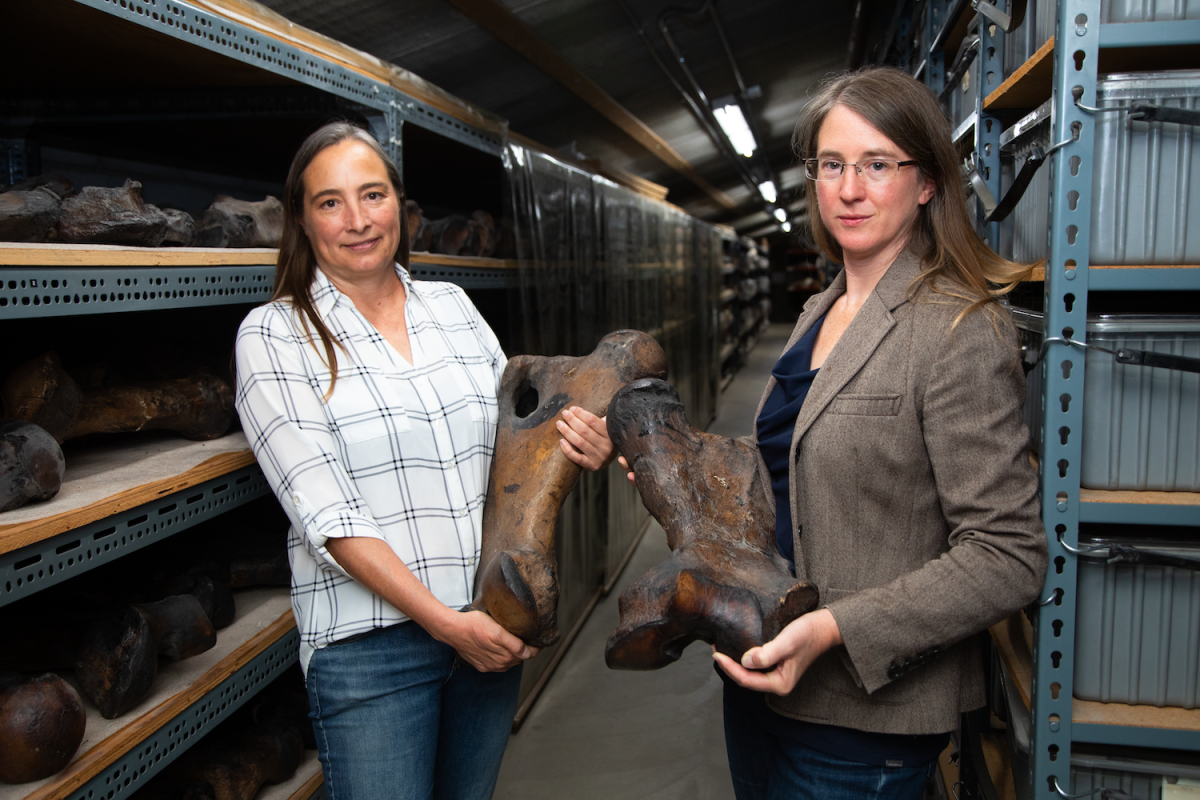
Worldwide, the period from 14,000 years ago to 13,000 years ago was unusually warm and dry. Air temperatures in Southern California rose an average of 5.6 degrees Celsius (10 degrees Fahrenheit). Vegetation grew incrementally drier.
Unlike today’s warming, which is largely driven by greenhouse gases generated by human activity, this long warming phase was a natural phenomenon, one of several climate oscillations in the late ice age.
Yet by the end of this long warming cycle, there was a new variable on the scene that hadn’t been present during previous dry stretches: humans.
The oldest human remains yet discovered in North America were found on the Channel Islands off the coast of Santa Barbara, and date back 13,000 years. Researchers suspect their populations were small, with large mammals still outnumbering their human neighbors by as much as 100 to 1, Lindsey said.
Yet even modest numbers of humans literally burned their way into history. As soon as humans arrive on the scene, “suddenly, there’s tons of fire in the record,” Lindsey said.
These massive fires changed everything, the researchers argue. While their sources of ignition were quite different from the power lines and exhaust pipes that tend to spark fires today, our Pleistocene ancestors had few tools at their disposal to extinguish a blaze once it spread out of control.
Accelerating wildfires played a key role in the Great Dying by destroying ecosystems too quickly for plant and animal species to adapt.
Once-abundant junipers and oaks could tolerate drought, but had no defenses against fire. They disappeared, and fire-adapted pines and chaparral took their place. In a landscape stripped of shade, shelter and hiding places, food chains were upended. Intense fire may have altered water flows or cut off migration routes.
According to the fossil record, all of this devastation took barely 200 years.
“This is the most significant extinction since a meteor slammed into Earth and wiped out all the big dinosaurs. It’s probably the first pulse of the extinction crisis that we’re in today,” Lindsey said.
The study’s authors noted the unsettling similarities between the late Pleistocene extinction and present-day climate conditions in the American West: higher temperatures, drier vegetation and a growing human population that can’t stop itself from setting things ablaze.
The events of 13,000 years ago show “what humans can do on even a small scale. Now magnify that by many orders of magnitude and this story is to some degree a vision of what our future may look like,” Kirby said. “Humans are impacting the climate, they’re impacting the ecology, they’re impacting the fire regime just like we saw in the past — but in a much, much more significant way.”
In California, wildfires caused by humans grow faster and become hotter than wildfires sparked by lightning, the studies show.
The starkest difference between then and now is that today, all of the factors that led to the extinction of the ice age mammals are bigger, faster or stronger.
We have more people, and more ways to spark fires beyond the humble campsite or lit torch.
The climate is heating up at an exponentially higher rate. In the late Pleistocene, it took 1,000 years for temperatures to rise 5.6 degrees C. In the Anthropocene, temperatures in California have risen nearly 2 degrees C in the last 100 years alone.
It’s not hard to imagine many species today shortly going the way of the saber-toothed cat.
“This study is a great example of how we can use the past to portend the future,” said Anthony Barnosky, a paleoecologist and emeritus professor at UC Berkeley who was not involved in the research. “What we are seeing today — increasing human pressures combined with and actually causing climate change — is like this lesson from the past on steroids.”
